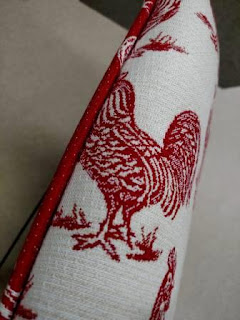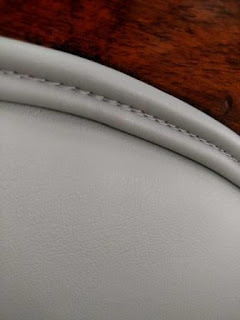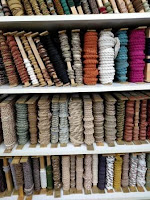Here, at last, is the long promised final installment of our SPOTLIGHT ON TECHNIQUE series on Decorative Trims: Piping, Welting, & Cording.
First, let me explain that there are many opinions about what, if anything, distinguishes piping, welting & cording from each other. Below I give my definitions.
Welt : a cord, made of tissue fibers twisted to form a rope, that is covered with fabric. Can be Single or Double. It comes in different thicknesses to create different effects. There is also plastic welt cord for applications that require a waterproof or washable welt.
 |
| Assorted Rolls of Welting Cord |
 |
| Purchased Cording with a “lip” |
Cording: Decorative, a rope-like trim. Usually ready-made. Can come with a lip or without a lip. The lip makes it easy to attach between two layers of fabric while creating your corded object.
 |
| Purchased Cording without a “lip” |
Piping (Also Single Welting): Piping usually refers to garment sewing whereas welting refers to home decor. Piping Cord is made of cotton or polyester, as opposed to tissue Welt Cord. Single Welting is the most versatile option and provides a coordinating or contrasting edge along the seams of slip covers, cushions, pillows, sofas, and more.
 |
| Slip Seat cushion with a contrasting Single Welt |
Double Welting: Double Welting provides a coordinating or contrasting edge along the edges of primarily chairs and sofas. It is attached with either hot glue or a special gimp stapler. You can use single welting to make double welting but it is easier to use special double welting cord.
 |
| Double Welt trim on a beautiful upholstered wood chair |
 There are many types of cording and welting to purchase…
There are many types of cording and welting to purchase…
OR you can make your own!
Making Your Own Single Welting/Cording
Using a 60″ metal ruler, cut a strip of fabric (usually on the bias for maximum flexibility) and fold it over the desired size of welting cord. Stitch in place and use like a lipped cord. Unless you’re very experienced (or brave!), in which case you can sew it directly into the open seam of the article you’re working on!
NEXT TIME: what topics would you like to see covered in our SPOTLIGHT ON TECHNIQUE? Drop us a line on Facebook and let us know your thoughts! Fabric Farms on Facebook
